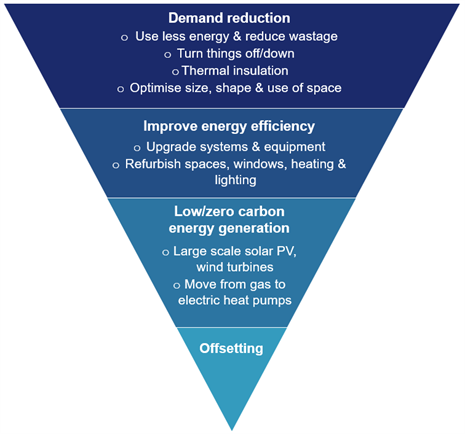Carbon and energy
Our ambition
In 2021, the university committed to a science-based approach to setting carbon reduction targets for our UK operations.
Initially focusing on scope 1 and scope 2 emissions, and using 2018/2019 as the baseline year, we have established the following ambitious carbon reduction targets in line with the Paris agreement:
2030 – 63% reduction in emissions (science-based target)
2040 – Net zero carbon target (with offsetting)
2050 – Absolute zero carbon target (without offsetting)
The delivery of this ambition requires us to reduce our scope 1 and scope 2 carbon emissions by 26,848 tonnes by 2030.
We support Nottingham’s ambition to be the UK’s first zero carbon city by 2028 and are working with partners in China and Malaysia to improve sustainability in their regions.

Our progress
Gas and electricity consumption on our UK campuses equates to around 40,000 tonnes a year.
Between 2010-2020, the university succeeded in reducing our carbon emissions by nearly 40%.
This means that the targets developed in our 2010-2020 Carbon Management Plan were exceeded by more than 2,000 tonnes.
Read more
We have now published the 2030 Carbon Management Plan which sets out the pathway to achieve net zero carbon emissions by 2040 or earlier.
Read the plan
Delivering our ambition
The Estates Development Framework and the campus planning process will provide the framework for how we will invest in and develop our estate. It will be a key enabler and delivery body for our carbon ambition.
Our plan takes a hierarchical approach to carbon reduction and includes several different interventions, investments and policies. This approach prioritises:

Carbon offsetting is used as a last resort for addressing the emissions that can’t be removed/prevented in any other way.
There are a few ‘one size fits all’ approaches that can be taken. Each targeted, low-carbon infrastructure investment will be looked at individually depending on location, age, condition, function, ownership and planned future changes.
Our plan initially focusses on our on-site carbon emissions. These scope 1 and scope 2 emissions are those which are under our direct control, such as emissions from fuels and heating sources.
There are significant challenges ahead in delivering against our scope 1 and scope 2 targets:
- Financing investment;
- Decarbonisation of heat (removing gas) in an aging estate;
- Future growth – targets will be absolute not relative;
- Delivering renewables at scale;
- The role of zero carbon power purchase agreements;
- How we define net zero / absolute zero/ carbon in-setting or off-setting;
The size and shape of the university will continue to evolve with the acquisition of new buildings and campuses, and the demolition and disposal of others.
We will embed low carbon principles into processes and policies and ensure that future projects do the same. For example, the proposed refurbishment of the Tower Building and Project Stay provide the opportunity to deliver reduced scope 1 and scope 2 emissions and minimise scope 3 emissions through the construction process.
New policies and specifications are a key tool for the delivery of our plan. These will support the delivery of net zero scope 1 and 2 emissions and minimise scope 3 emissions both during construction and operation by helping to guide and support capital investment decisions and design.
Complex specifications and standards will support the construction and redevelopment of our estate, including a review of our environmental building standards.
Work has begun on developing many of these policies and standards and these will be published in 2022.
Use of gas policy
Currently the majority of the heat the university generates for space and water heating uses natural gas. The emissions from gas consumption make up around 50% of our total scope 1 and 2 carbon emissions.
We have already published a use-of-gas policy. This states that all new build projects will be designed without natural gas supplies. Plus, deep refurbishment must include high levels of thermal insulation to all the main building elements.
This reduces energy demand by allowing heating systems to operate at low temperatures which enables no-gas/ low-carbon heat sources (e.g. heat pumps) to operate effectively.
Scope 3 emissions
As a large complex organisation, 80% of the universities total carbon footprint relates to emissions that are not in our direct control (scope 3). Whilst we haven’t set targets for these emissions yet, we have identified four key areas to target and actions plans are in development.
- Construction and refurbishment
- Paper use
- Food and catering
- Business travel
Together these account for more than half of our scope 3 emissions. Work is already underway to more accurately measure and manage emissions from these sources and we have been consulting with staff on issues surrounding business travel.
Role of our community
As well as specific policy and project interventions, people are at the heart of the delivery of our plan. It is vital that we empower everyone in the university to take personal, positive action to reduce energy use through behaviour change. To do this, active engagement and support from the university community will be essential. Our ‘go!’ campaign will be an important part of the delivery of this plan.
We will continue to run events and campaigns that enable staff and students to contribute to meeting these carbon reduction targets. See how to get involved.
Energy audits
Plant Sciences energy survey
Chemistry energy survey
Vet School energy survey